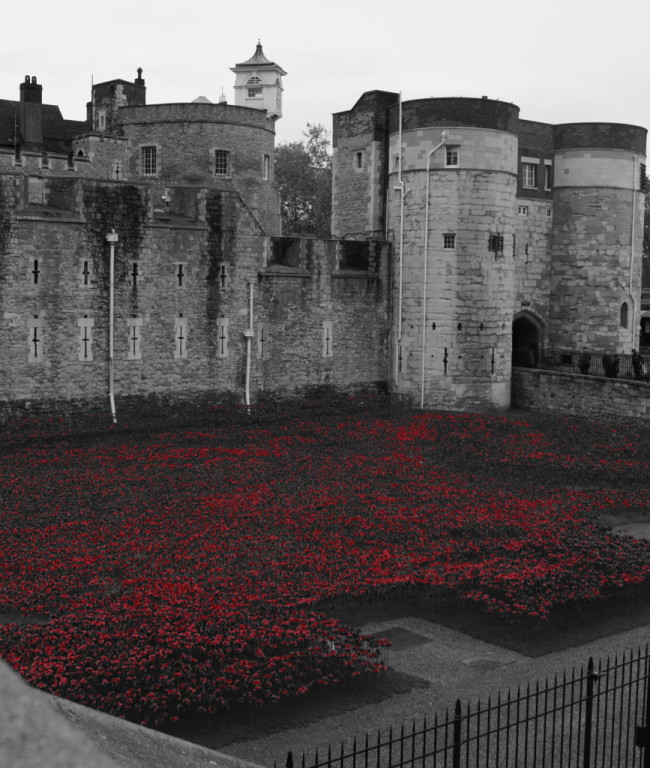We Remember…

This was the first November in decades that I have been able to wear a poppy to commemorate the end of World War I on November 11. Why? I now live in Japan, and they were on the losing side. Peace is celebrated and war is denounced but not on November 11. Poppies also do not have the same significance in Japan. What was different this year? I was lucky enough to be in London and I was lucky to be one of thousands who went to see the installation Blood Swept Lands and Seas of Red at the Tower of London. The ceramic poppies were made by Paul Cummins and, with the cooperation of setting designer Tom Piper, mark one hundred years since the first day of Britain’s participation in WWI. This was at the top of my list of things to do.
Yes, the sea of poppies was another one of many installations consisting of multiples but that method was appropriate this time. The vast number gained more publicity, and more flowers meant more money could be collected for charity by selling the flowers. The mayor of London recognised their popularity and wanted the organizers to remove the flowers at a later date, extending their popularity. Two cascades of flowers will be on display for an extra two weeks: the one at the entrance and the one on the tower.
Poppies to insert in lapels were being sold at train stations throughout the city. Being a Canadian, I was used to fuzzy four-petaled red poppies with a plastic backing and a green felt centre. Stems were insignificant. Kids sometimes fold them in half and use them as fake lips. The British ones were two semi-circles of construction paper with a black button at the centre; the stems were green plastic. More expensive versions were also sold. Cultural differences on a small scale.
 I cannot have been the only one experiencing some cultural shock. The Tower of London was packed with
I cannot have been the only one experiencing some cultural shock. The Tower of London was packed with  thousands of tourists from all over the world. Some people have decried the use of a poppy to represent war, but the simple beauty of the poppy could easily be appreciated by all, including the Japanese, Italian, and German tourists who fought against Britain and its allies in WWII. Poppies flooded the moat and were on almost everyone’s lapels. The little poppy provided a chance for discussion despite the debate about its use. Everybody enjoyed its beauty.
thousands of tourists from all over the world. Some people have decried the use of a poppy to represent war, but the simple beauty of the poppy could easily be appreciated by all, including the Japanese, Italian, and German tourists who fought against Britain and its allies in WWII. Poppies flooded the moat and were on almost everyone’s lapels. The little poppy provided a chance for discussion despite the debate about its use. Everybody enjoyed its beauty.
*Note: Several people have pointed out that Japan was an ally of Britain in WWI, so the idea of the poppy not being used in Japan because they lost has no validity. It was the best reason I could come up with at the time when I had to explain it to Japanese friends in London when they were seeing poppies everywhere. Americans refer to November 11 as Veteran’s day. Maybe it is just a Commonwealth thing? Japanese friends were surprised that Canadians do not buy red feathers to support Red Cross activities. One more similarity that is also different.
The poppies were incredibly popular. People were warned to be patient with the long lines. Even with the cloudy skies, the poppies were a photographer’s delight ーeven if the average tourist was not allowed to walk in the moat amidst the flowers. Near the infamous London Bridge, people crowded against the rails. It was ironic, considering that the Tower of London was used as a prison. Like a lucky fountain of water, children tossed coins into the moat, and pennies were scattered amidst the leaves.
With so many people, security forces did not rest. Guards, both human and canine, explored the grounds.
In Flanders Fields
John McCrae
In Flanders fields the poppies blow
Between the crosses, row on row,
That mark our place; and in the sky
The larks, still bravely singing, fly
Scarce heard amid the guns below.
We are the Dead. Short days ago
We lived, felt dawn, saw sunset glow,
Loved and were loved, and now we lie
In Flanders fields.
Take up our quarrel with the foe:
To you from failing hands we throw
The torch; be yours to hold it high.
If ye break faith with us who die
We shall not sleep, though poppies grow
In Flanders fields.


















Leave a Reply